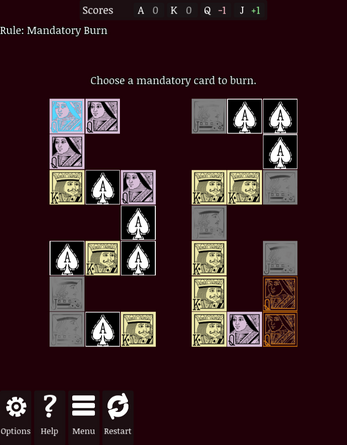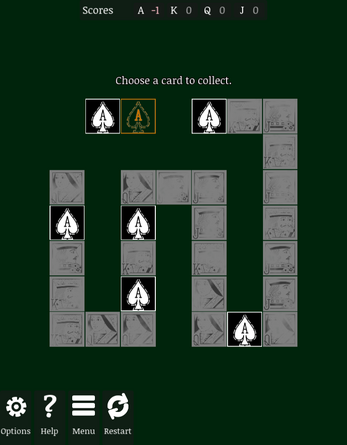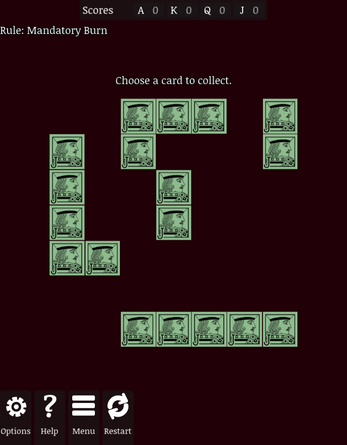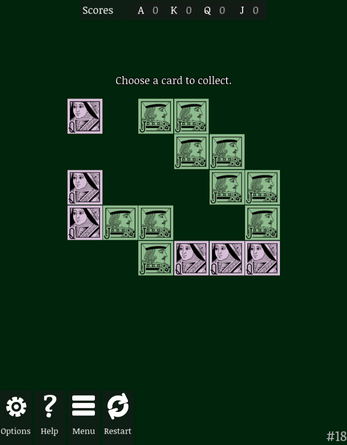Aces' Nim
Aces' Nim is a deceptively simple game about collecting cards. Each turn, you choose a card to collect and (possibly) an adjacent card to burn; then your opponent does the same. This apparently simple framework leads to surprising and beautiful strategic calculations. The overarching puzzle of the game is to work out the principles that will allow you to deduce the winning move in each position: every position generated in the game is guaranteed to be winnable with perfect play.
Aces' Nim is heavily inspired by the theory of combinatorial games, as described by Berlekamp, Conway, and Guy If you enjoy the game, please consider it as an invitation to that fascinating field! (You can find some references for learning about it further in the Credits section of the Options screen.)
Rules
Each turn, you will collect a card, and may also burn a card adjacent to the card you collected. Then your opponent does the same. Clicking (or tapping) a card selects it to be collected. Then you may either click an orthogonally adjacent card to burn it, or you may click the selected card again to collect it without burning anything. Clicking a blank space will deselect the selected card.
Each rank has a score. The first card collected in a rank is worth 1 point for the player who collected it.Subsequent cards in that rank are worth 2 points. A positive score means you are winning in that rank; a negative score means your opponent is winning in that rank. Burned cards earn no points. At the end of the game, whichever player is winning in Aces wins the game. In the unlikely event of a zero Ace score, the player who is winning in Kings will win the game, followed by Queens and finally Jacks.
Collecting a card makes all cards of lower ranks inactive, indicated by a faded gray appearance. Inactive cards can no longer be collected (but are still eligible to be burned). The game ends when all remaining cards on the board are inactive. Some of the later designed boards use the mandatory burn rule, indicated by a dark red background. When this rule is active, you must burn an adjacent card whenever you collect a card; cards with no adjacent card to burn automatically become inactive. (You can also choose to use this rule for random boards.)
| Updated | 1 day ago |
| Published | 3 days ago |
| Status | Released |
| Platforms | HTML5 |
| Rating | Rated 5.0 out of 5 stars (1 total ratings) |
| Author | puleo |
| Genre | Puzzle, Card Game, Strategy |
| Made with | Aseprite, Godot, Rust |
| Tags | combinatorial, Math, No AI |
| Average session | A few minutes |
| Inputs | Mouse, Touchscreen |
Development log
- New Game -- Aces' Nim3 days ago




Comments
Log in with itch.io to leave a comment.
I thought I had the logic down for the first few levels.
Then Mandatory Burn happened. 🙃
That was my experience as well when I was trying to figure this out on paper before I built the webgame! Under optional-burn rules the different ranks can't really interfere with each other in any meaningful way so you can analyze them pretty much independent of each other. But with the mandatory burn rule, suddenly burning a Jack can mean that, e.g., the Ace next to it no longer has a neighbor available to burn.
At some point I might write up my analysis of the game in a dev log, but for now I'll say that I do think there's still a nice theoretical solution for working out which positions are winning positions. (Writing the whole thing up now and posting it feels a bit like it'd just be spoiling the game right out of the gate for anyone who wants to grapple with it for a while.)